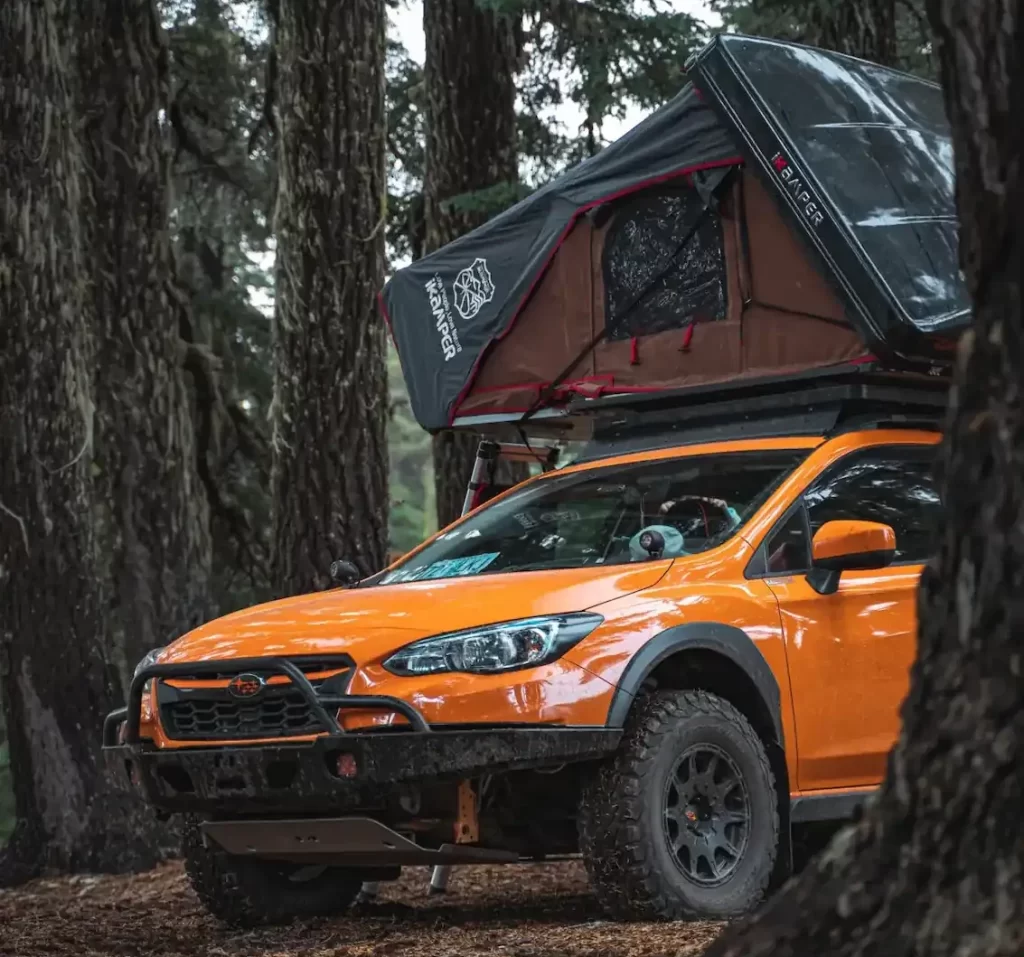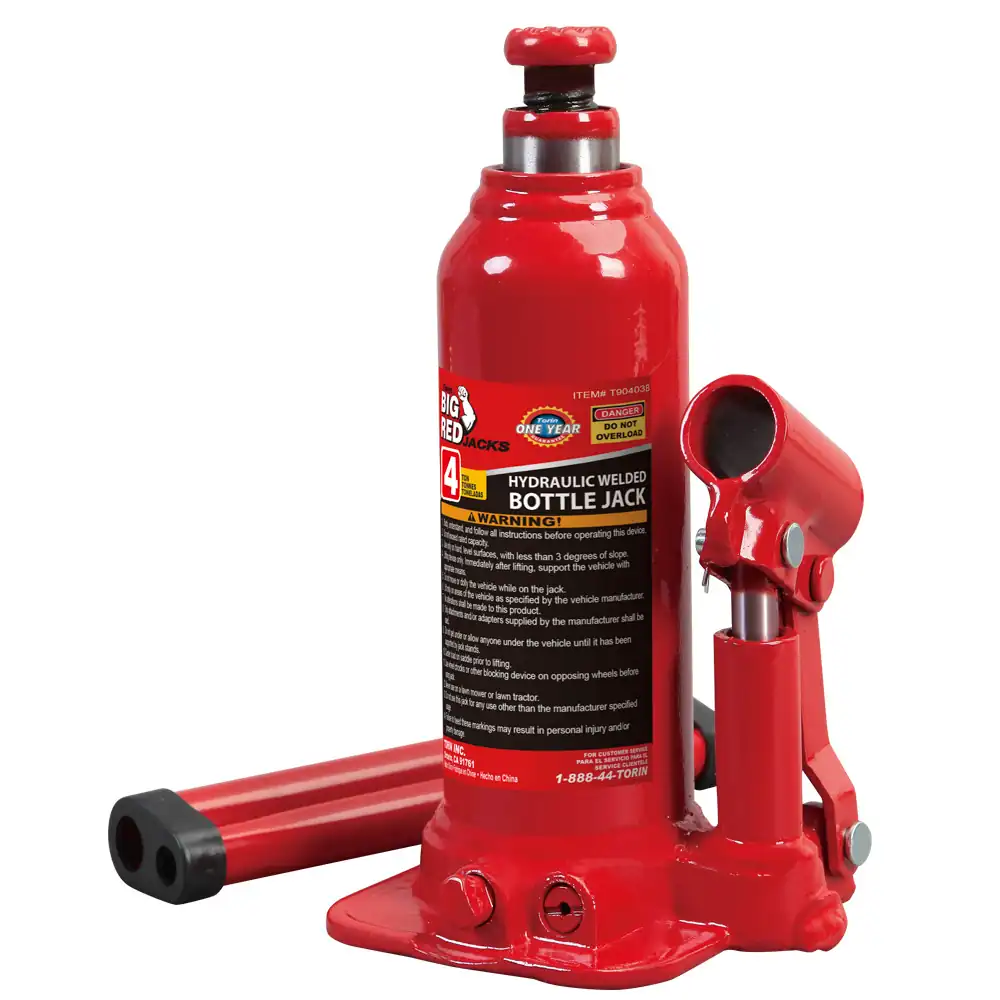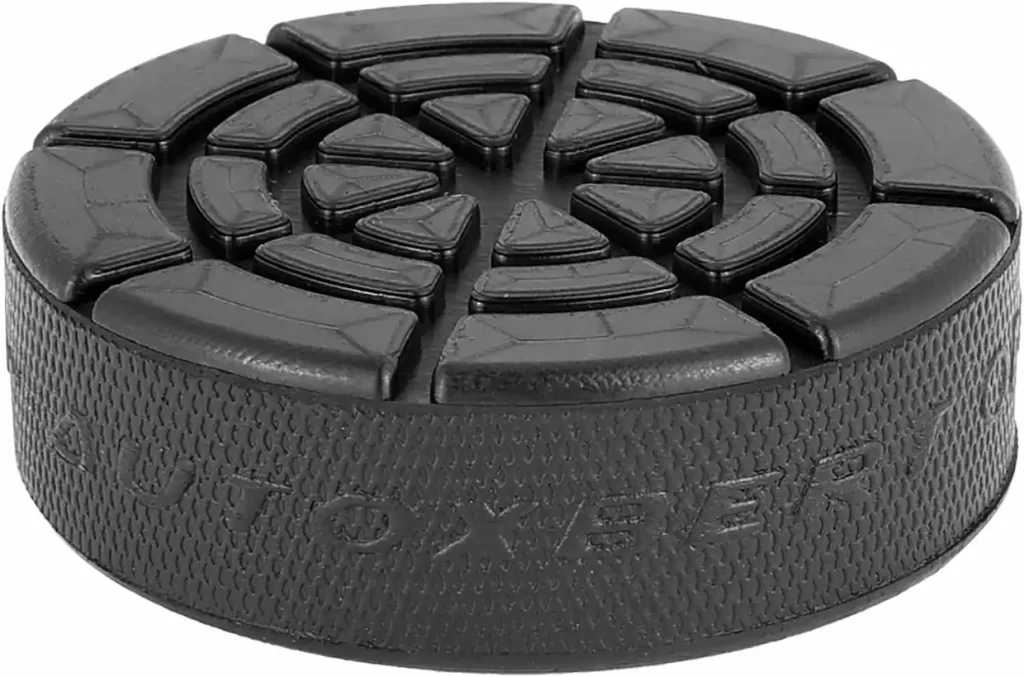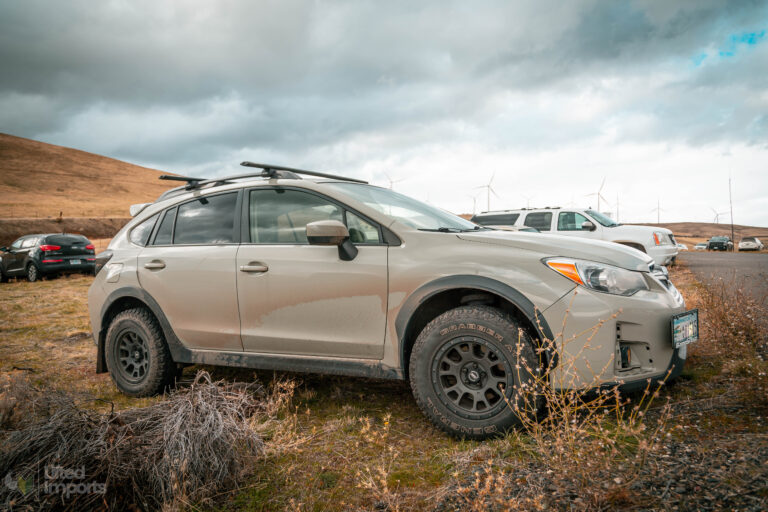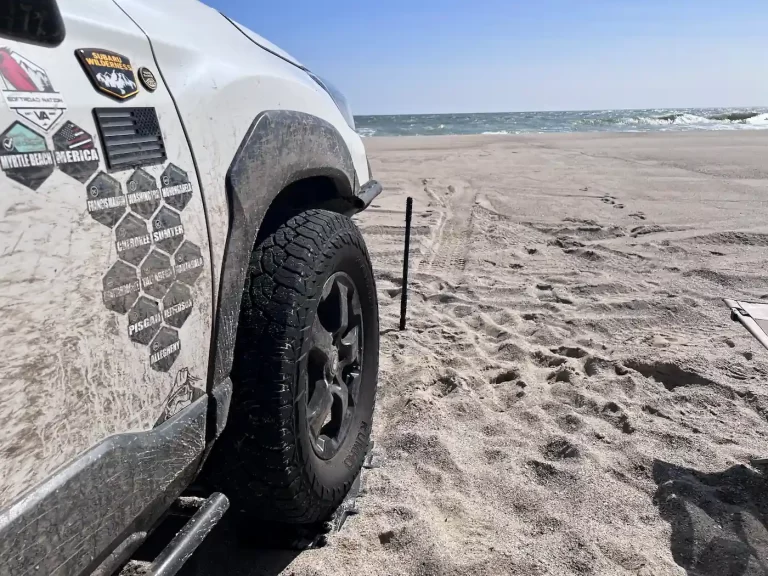
Most people are somewhat familiar with basic recovery and offroading techniques. But when going offroad in a Subaru, there are some specific things that I have found to be a bit different than when driving a traditional 4×4.
When planning an offroad day in your Subaru, ensuring your safety and the safety of your passengers is paramount. Offroading can be an exciting and a ton of fun, but you have to remember that we’re effectively using heavy machinery and need to be prepared accordingly.
Let’s jump in and I’ll share some of the most important things I’ve learned over the last ten years of offroading.
Table of Contents
Recovery Gear
One of the first items to check off your off-roading safety checklist is a few pieces of essential recovery gear. These can be used to help recover your Subaru, or someone else’s vehicle. I carry a handful of essential items in both of my offroad cars.
This gear includes items like:
- recovery rope
- recovery shackles (I personally use soft shackles)
- a winch (optional)
- shovel
- a bottle jack.
These tools can prove to be lifesavers if your Subaru gets stuck while on the trails.
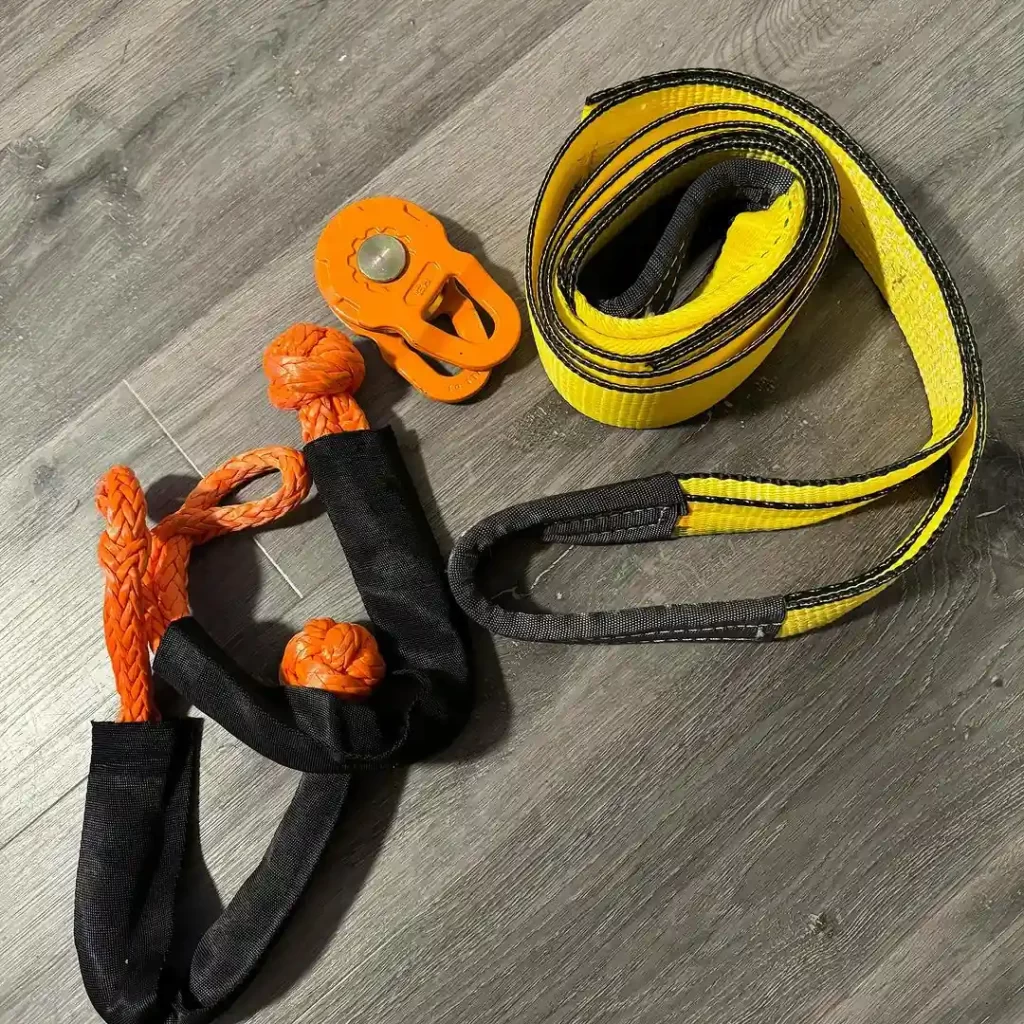
Recovery Ropes & Shackles
These two items are crucial for vehicle recovery. When used correctly, they allow another vehicle to pull yours out of a tricky situation. I personally prefer using a kinetic recovery rope over tow straps. I also like using soft shackles in most situations as they are quick, safe, non abrasive, and don’t sink in water or mud.
Soft shackles can also fit around oddly shaped recovery points like axle tubes or tie down points that are tucked up in tight spaces. I also appreciate that they are much less likely to pose a fatal risk in the event of a winch line failure.
Before performing a recovery, make sure you know which points on the vehicle will be safe for pulling. I prefer to use a trailer hitch receiver as a recovery point. I always avoid the eyelets you may find that screw in behind the bumpers. These are not strong places to pull from and can create a dangerous situation.
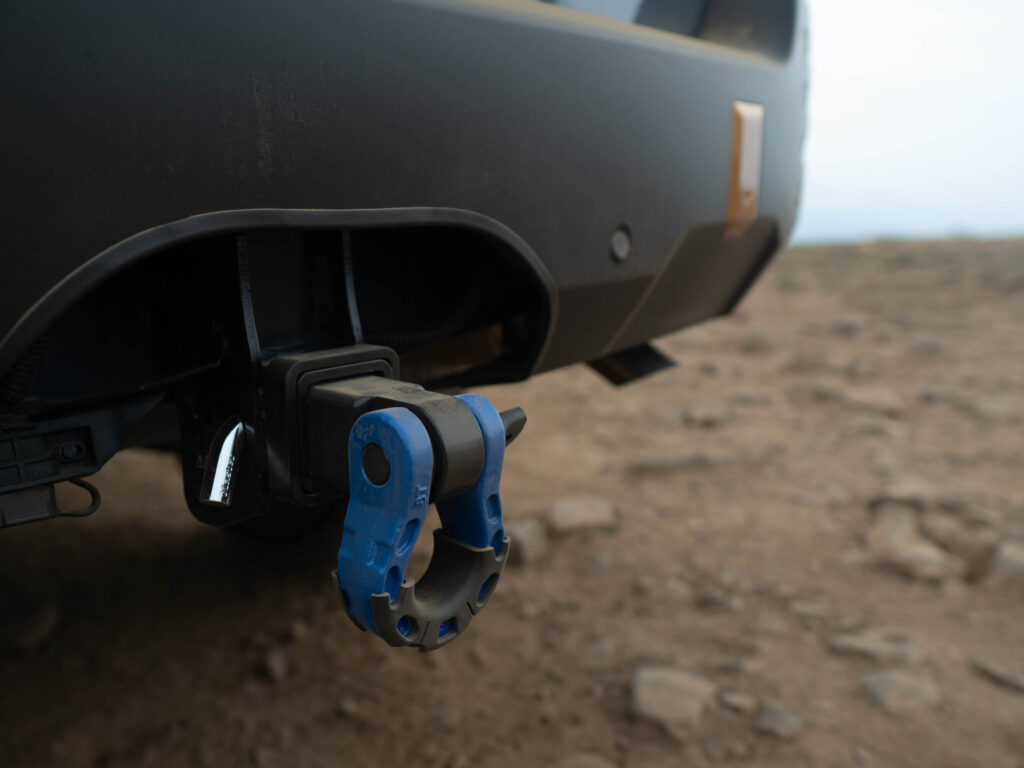
Winch (Optional)
A winch is particularly handy when there are no other vehicles around to assist. It can help you self-recover in situations where you’re stuck or in a tight spot. However, a winch isn’t necessarily feasible for some people. Mounting a winch on a Subaru is usually challenging and is one of the most expensive pieces of recovery equipment. But if a winch fits in your budget, they are very convenient!
Most people suggest having a winch that is rated for double the weight of your vehicle. But a 5500 lb winch is typically more than enough for most Subarus and it’s difficult to fit anything bigger. 5500 lbs is usually sufficient since they are very rarely buried the way that many 4×4’s may find themselves stuck. Simply carrying a snatch block can allow you to double your pulling power which turns your 5500 lb winch into an 1100 lb winch.
If you’d like to see some of my favorite winches specifically for Subarus, check out my article “Best Subaru Winches.”
Bottle Jack
Having a jack while on the trails provides a way to lift your vehicle’s wheels out of ditches, above the snow, and out of other sticky situations. Many times, a jack can allow you to lift a wheel far enough off the ground to put recovery boards or rocks under your tires. Then when you lower the vehicle back down, you can simply drive out of whatever the car was stuck in.
I personally prefer bottle jacks for Subarus because they’re very small, extremely powerful, and reliable. I use a jack pad to put under it, and a special pinch weld jack pad to allow for a strong lifting point.
Emergency Kit
Whether you’re going off-roading for a few hours or heading out on a multi-day overlanding adventure, having an emergency kit on hand is essential. This kit should include first-aid supplies, basic tools, a flashlight, and extra batteries. You never know when you might need these essentials, especially when you’re far from civilization.
Basic First Aid
Your kit should include bandages, antiseptic wipes, pain relievers, adhesive tape, and any personal medications you may need. Admittedly, I need to learn more first-aid techniques. But nevertheless, knowing how to use the items to administer possible life-saving first-aid is essential.
Tools
Carry tools like a multi-tool, pliers, wrenches, and a tire repair kit. These can be invaluable for making quick fixes on the trail. I also carry a set of ratcheting wrenches, and a socket set. Additionally, I bring things that I suspect there’s even a slight chance I may need. For example, if I’m going somewhere with the chance of water crossings being unavoidable, I carry a spark plug socket and extensions in case I have to purge the cylinders. Some people even carry spare axles and tie rods if they’re planning to do difficult trails.
Fire Extinguisher
I think everyone should carry a fire suppression tool of some sort in every vehicle – even if it’s not being used offroad or on the track. I carry an extinguisher in each of my cars.
Hopefully you’ll never have to use it, but it’s so much better to have it on hand. Things like brake line or fuel line failures can send a car up in flames within a matter of seconds.
To learn how to appropriately and effectively use a fire extinguisher on a vehicle, you can visit in2fire.com to go through all the steps. But one important thing to remember is that you should not open the hood in the event of an engine compartment fire. Only release the hood latch. Opening the hood will feed oxygen into the fire causing it to grow exponentially.
Light Source
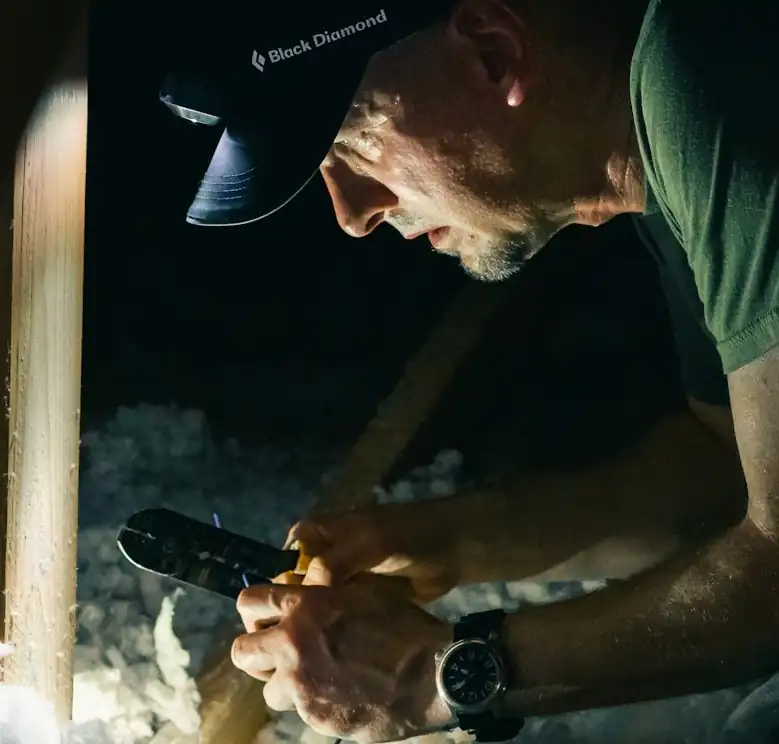
It’s very important to have a light source available to you. Opt for a durable, high-powered flashlight or headlamp with extra batteries.
I prefer a headlamp so that I have both hands free to work on things. A magnet light or a light with a hook is also useful when working under the hood. A good light is your lifeline when darkness falls, and you need to handle a situation or make repairs.
Tire Prep
Proper tire maintenance is crucial for off-roading safety. Your tires are your connection to the trails and they play a significant role in your Subaru’s off-road capability. Here’s what you should consider:
Tire Pressure
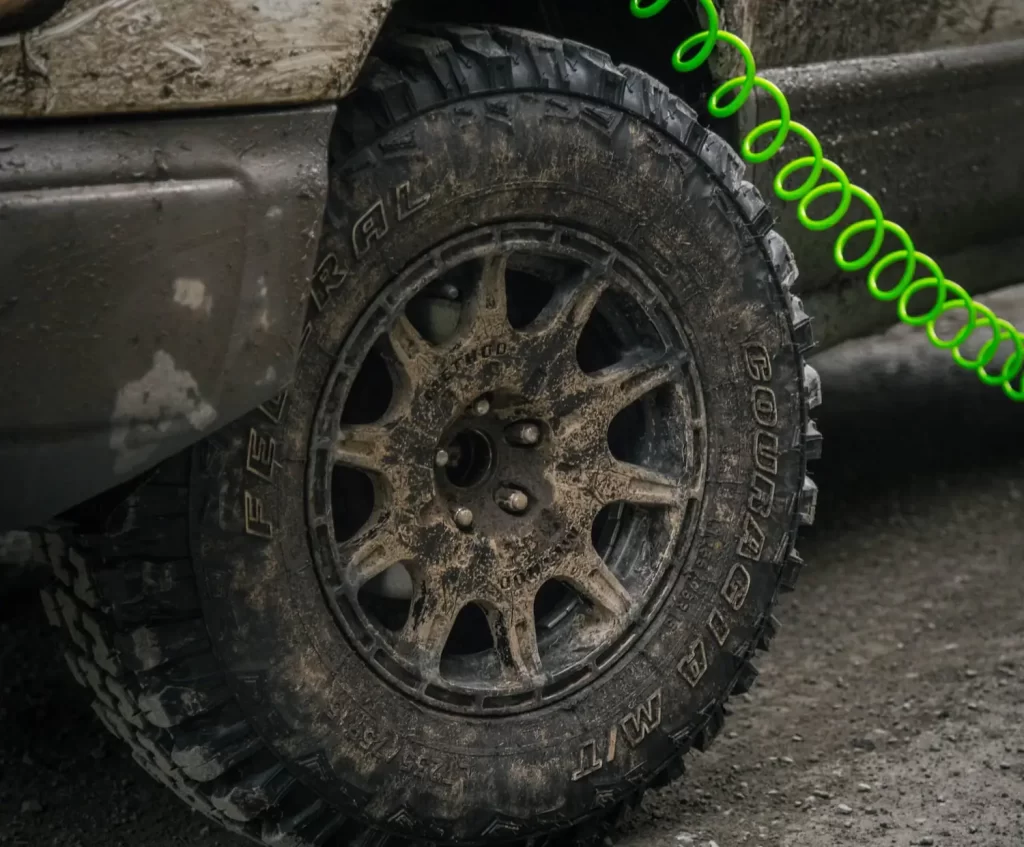
Adjust your tire pressure according to the terrain. Lowering the tire pressure provides better traction on soft surfaces like sand or mud. However, be sure to re-inflate your tires to the recommended pressure when returning to paved roads. I always carry a Viair portable compressor with me to quickly air up.
You’ll want to experiment with different amounts of psi. But I like to run 15psi when I’m on trails with lots of sand or rocks. Sometimes I run more and sometimes I run less – especially if I’m in deep snow.
Tread Depth
Check your tire tread depth regularly as they age. Deep treads offer better grip and prevent slipping on uneven terrain. Replace your tires if the tread is worn down beyond safe levels. Typically, I find that a good set of all-terrain tires provide enough grip to be effective on trails for 40-50k miles. I usually replace them a little early so that I have as much grip as possible.
I also like to inspect the tread from under the car so I can see if there is any uneven wear forming on the inside of the treads. This can be a sign of worn suspension components or bad alignment.
Tire Selection
Invest in a quality set of all-terrain or mud-terrain tires. These specialized off-road tires are designed to handle rough terrain and provide superior traction even in slippery conditions.
Most people can use a set of all-terrains but if you go off-road very regularly or if the trails you do are advanced, a mud terrain is a good option.
Additionally, a full size spare is also a great thing to carry with you. Most people carry their full size spare on their roof basket, but there are many other ways to safely carry it without having to put it all the way on the roof. You can see those options in my spare tire storage article.
If you’re not sure what the best tire options are for you, this article will help get you started in the tire shopping process!
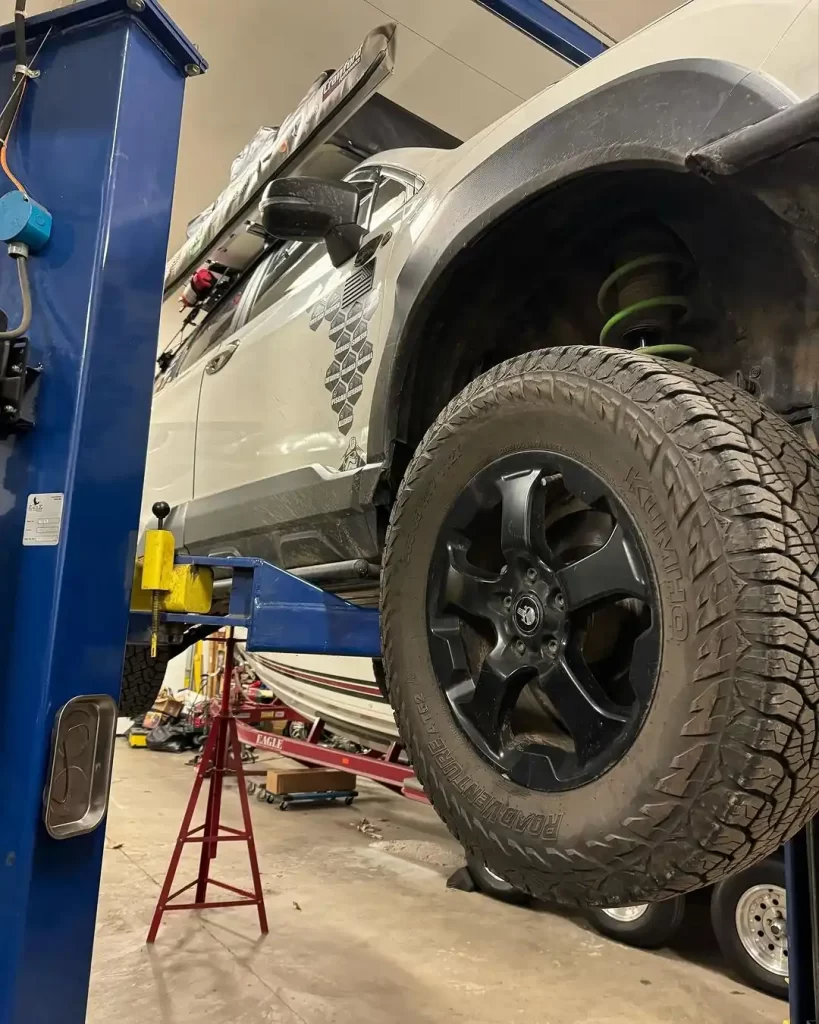
Plan Your Route
Planning your off-roading routes in advance is a must for a safe and enjoyable adventure. Here are some steps to consider before heading out:
Research
Use maps, GPS devices, or off-road apps to research the trails and routes you intend to explore. Look for trail difficulty ratings, trail conditions, and any recent reports from other off-roaders. I personally enjoy the onX Off-Road premium app. It works really well and has tons of information. Gaia is another app that I use and they have a free version that still allows you to record your path.
Share Your Route
Always share your planned itinerary with someone who won’t be joining the trip. Provide them with details about your route, expected return time, and emergency contact information. This ensures that someone knows your whereabouts and can contact help if necessary.
I’ve personally been in situations where I was alone and my car was stuck. Fortunately I was able to hike out to cell service. But it opened my eyes to how important this could be in cases where you may become incapacitated by an injury.
Check Regulations
Confirm that the trails you plan to visit are open and accessible. Some off-road areas may have seasonal closures, and it’s essential to respect all posted rules and regulations.
Certain areas may also require a pass in order to access trails without receiving a citation. These passes also help fund patrols and maintenance of the areas. As easy as it is to feel annoyed with a law enforcement presence in these areas, it’s much better than dealing with illegal activity taking place in the woods that can eventually lead to restriction in public access.
Vehicle Inspection
Before embarking on any off-roading adventure, conduct a thorough inspection of your lifted Subaru. Check for loose bolts, leaks, or any signs of wear and tear that may present an issue while on the trails. Here’s a basic checklist to follow:
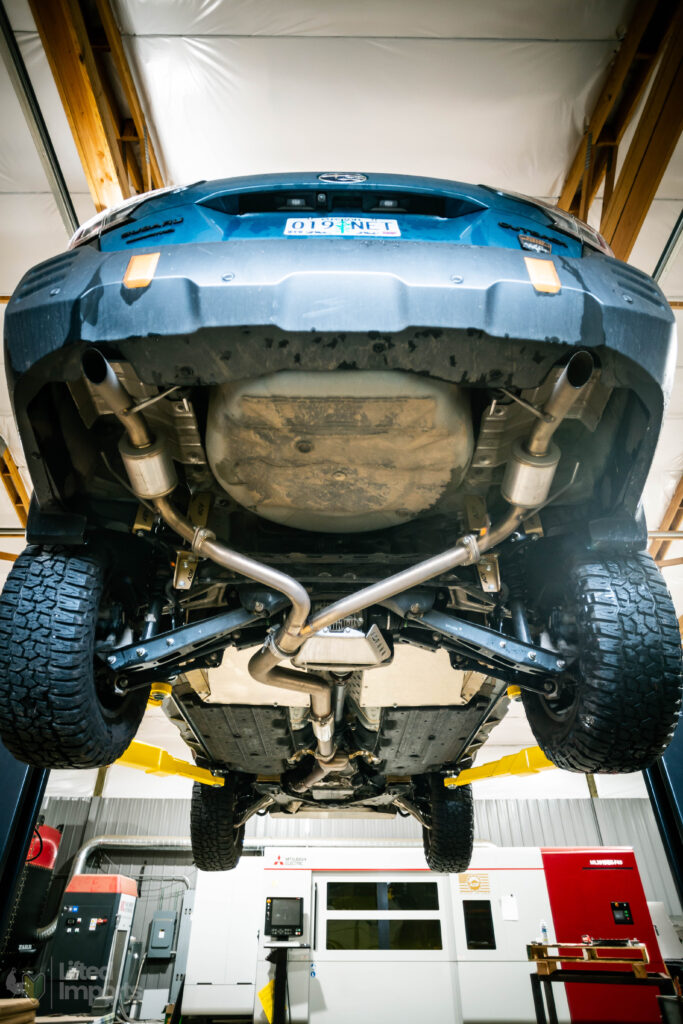
Suspension
Inspect your lift kit components and suspension for signs of damage or wear. Ensure that all bolts and connections are tight and secure. If anything is loose, snug it up to the correct torque spec.
Fluids
Check your vehicle’s fluids, including engine oil, transmission fluid, brake fluid, and coolant. Top off any fluids that are low. Don’t forget wiper fluid. It can be frustrating to not be able to easily clear mud or dust off your windshield easily.
I also routinely check my front and rear differential fluids. I do this at every oil change to make sure they’re full and that the gear oil is still good (I always change dark fluid or overly metallic fluid.)
Brakes
Ensure that your brakes are in good working condition. If you hear any unusual noises or experience brake fade, address the issue before heading out. A loss of brakes while on a steep trail is not safe for obvious reasons.
I inspect my brakes at every oil change looking for leaks and checking brake pad depth. I also make sure there’s no debris stuck in my calipers or pads.
Undercarriage
Give the undercarriage of your Subaru a general “once-over” for any damage or loose parts that seem out of place. Off-roading can result in all sorts of damage to various items under the vehicle so it’s essential to keep an eye on it.
Lights and Signals
Test all your lights, including headlights, taillights, turn signals, aftermarket light bars, and brake lights. Functional lights are crucial for safety, especially when off-roading in low-light conditions. One way that I do this if I don’t have an assistant is to set the phone up near my car and record myself testing the lights. You can then watch the video and see if anything failed to function correctly.
By conducting a thorough vehicle inspection, you can catch and address any issues before they become bigger problems on the trail. This not only enhances your safety but also prolongs the life of your Subaru.
Travel In Groups
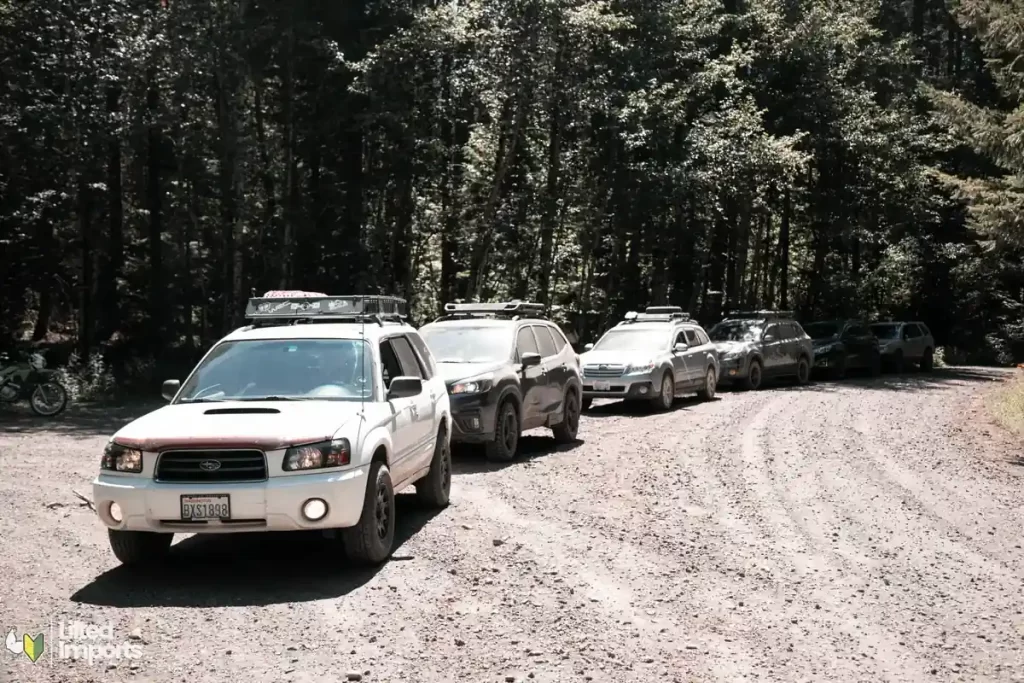
Whenever possible, consider going off-roading with a group of fellow enthusiasts. There are several benefits to traveling in a group:
Safety In Numbers
Group travel provides a safety net. If one vehicle encounters difficulties, the group can work together to overcome challenges, such as winching or towing a stuck vehicle. Larger groups of fellow off-roaders also means that your chances of having access to a specific tool are greater.
One of the local groups I do trail runs with regularly invites newcomers to join our adventures. It’s not uncommon for someone who is newer to off-roading to not know how to patch a tire or properly winch out of a ditch. We always have a great time helping people learn new skills.
Community

Off-roading with friends or fellow enthusiasts enhances the experience a lot. It’s an opportunity to share stories, learn from each other, and enjoy the camaraderie of like-minded individuals.
Some of the people I know from running trails together have become great friends outside of the car community.
Navigation
Having multiple vehicles means the group is more likely to navigate correctly to the destination. Even if just one vehicle is equipped with GPS or has off-roading apps, they can guide the rest of the group through challenging terrain and provide support on challenging sections of the trail. There will also likely be a greater knowledge base regarding the area if there’s more people present.
There is of course a limit to the number of vehicles that makes an off-road excursion fun. But I prefer driving trails in a group of 5-10 cars. Anything more than that usually presents logistics issues and makes it hard to connect.
Recognize Your Limits
As you gain experience with off-roading, it’s crucial to understand both your own limitations and the capabilities of your lifted Subaru. Here are some considerations:
Be Realistic With Your Off-Roading Ability
Be honest about your off-roading skills. If you’re a beginner, start with easier trails and gradually work your way up to more challenging terrain as your confidence and experience grow.
Do you understand strategic line choice in Subarus? Are you familiar with how to operate and use all of your recovery equipment?
Always be looking for chances to drive trails with more experienced off-roaders as you progress into a well-rounded wheeler.
How Capable Is Your Car?
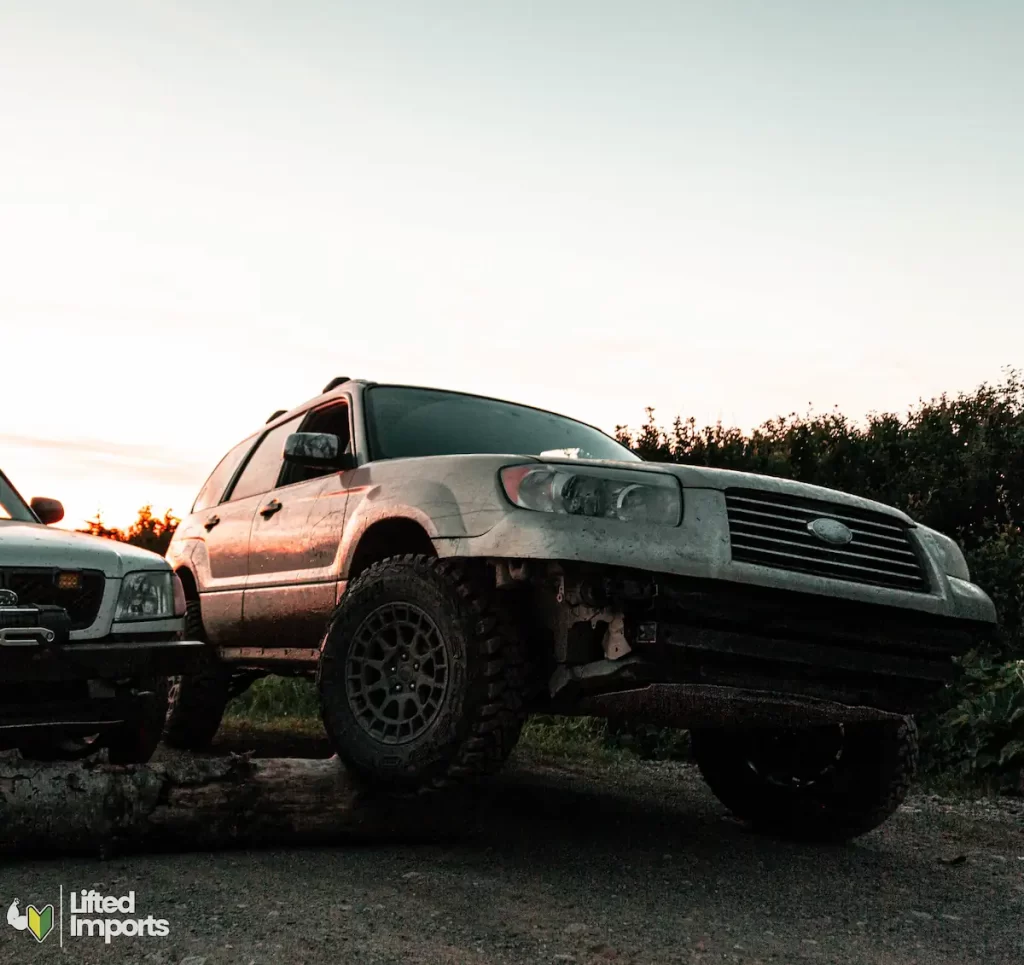
While lifted Subarus can handle a variety of off-road conditions, they may not be suitable for extremely rugged or overly steep terrain. Know your vehicle’s limitations and avoid tackling trails or obstacles that exceed its capabilities.
If a trail that I’m researching has unavoidable objects that require big tires and a low gear, I typically take my Jeep instead. As much as I love driving my Subie on trails, I don’t want to damage it or get completely stuck on the trails. Since Subarus don’t have a 4LO, I try to avoid anything that requires slow crawling up or over steep objects.
Assess The Trail
Before attempting a challenging section of the trail, take the time to assess the terrain and plan your approach. Look for potential obstacles, mud pits, rocks, or steep inclines, and decide if your vehicle and skills are up to the task. I always check the depth of any water or mud that I can’t see the bottom of and I make sure there’s always an backup plan if I can’t make it up a certain line.
Offroading in a lifted Subaru is some of the most fun I’ve ever had, but it comes with its responsibility to be proactive. Prioritizing safety is essential and ensuring you have the right recovery gear and an emergency kit at hand is a must.
Pay close attention to your tires and maintain your vehicle. Plan your routes wisely, share your itinerary, and respect regulations. Remember, traveling with a group provides safety and camaraderie.
Finally, always acknowledge your own and your vehicle’s limitations. By following these steps that I use, you can enjoy the excitement of off-roading while keeping yourself and your Subaru safe on the back roads. See you on the trails!
Related Articles:
As an Amazon Associate we earn from qualifying purchases

